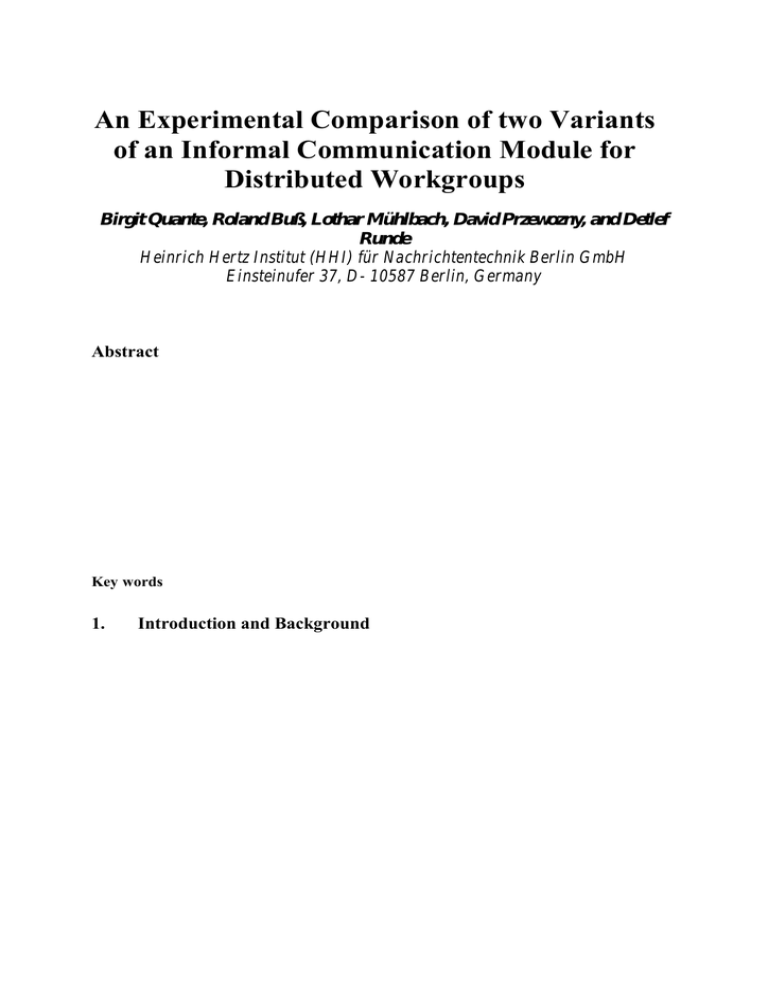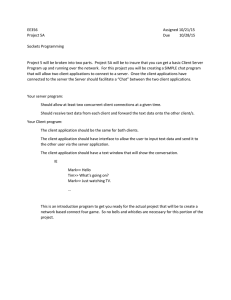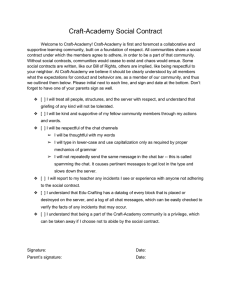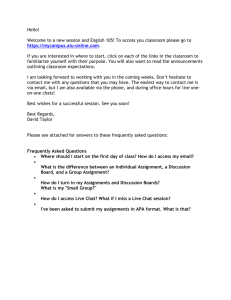An Experimental Comparison of two Variants of an Informal
advertisement

An Experimental Comparison of two Variants of an Informal Communication Module for Distributed Workgroups Birgit Quante, Roland Buß, Lothar Mühlbach, David Przewozny, and Detlef Runde Heinrich Hertz Institut (HHI) für Nachrichtentechnik Berlin GmbH Einsteinufer 37, D- 10587 Berlin, Germany Phone:+49 30 31002 677, E-mail: quante@hhi.de Abstract We developed a module aimed at enabling informal communication for distributed workgroups and examined two variants of that module within the framework of a field trial, in which three workgroups participated. One variant came with a ‘conventional’ user interface, enabling (textual) communication similar to common chat systems. With the second variant users could communicate by means of a virtual environment in which they were represented by avatars. Information on the users' availability for communication was provided by the module BINDI (Busy INDIcator). Among other things, it enabled the user to check whether a potential communication partner was at his or her workplace, was currently talking, or was using the computer. Data analysis showed, among other things, that information on the current availability of potential communication partners seems to be crucial for informal communication in distributed workgroups and that a virtual environment can only be beneficial if it comes with a high degree of usability. Key words: informal communication, telework, tele co-operation, virtual environments, chat, availability information, awareness information, workgroups 1. Introduction and Background Telework, distributed workgroups and virtual enterprises will be common in the near future. Formal communication and collaboration within the framework of these working schemes can be supported by groupware or by conventional telecommunication systems such as telephone, fax or e-mail. However, the–not less important–informal communication (Kraut, et al., 1990) is usually not supported to the same extend. The characteristics of informal communication are that it is spontaneous, coincidental and impromptu. It happens on office floors or in the course of coffee breaks of a congress. Various studies have shown that informal communication is crucial for creative workgroups, such as research and technological development teams (Kraut & Streeter, 1995). This applies not only to the well-being of the group but also to its efficiency and productivity (Suwita & Mühlbach, 1997). Considering this, several attempts have been made to develop systems that support informal communication. Among those are the VideoWindow (Fish, et al., 1992), the Cruiser (Root, 1988), the Polyscope system (Borning & Travers, 1991), the Electronic Agora (Travis, 1995), the FreeWalk system (Nakanishi, et al., 1996), the Piazza (Isaacs, et al., 1996), and various 1 Besides this virtual environment presentation, VE came with a central page which informed about who of favourite communication partners ("buddies") was logged in and about links to additional functions and options of the program. The main part of that page consisted of a Web page presenting availability and calendar information of all group members. 3. Field Trial In order to examine the possibilities and restrictions of the variants Chat and VE and the usefulness of the availability information provided by BINDI we ran an experimental field trial. Our main focus was the extent to which such communication systems could support informal communication between members of a distributed work group in their every day working life. 3.1 Experimental Versions Different versions of the two variants were used in the field trial (see Table 1): Table 1: overview of the experimental versions No. variant version availability info permanent A-Bar 1 Chat standard absent, talking, using PC, task no 2 Chat A-Bar absent, talking, using PC, task yes 3 Chat reduced no no 4 VE standard absent, talking no 5 VE A-Bar absent, talking yes 1. Chat standard: as described above. 2. Chat A-Bar: as Chat standard with an additional Availability-Bar (see on the right), which could permanently present the availability icons (see Figure 1) of all group members. 3. Chat reduced: only the chat software in the narrower sense like common IRC clients (IRC = Internet Relay Chat), no availability frame, no permanent Availability-Bar 4. VE standard: as described above. 5. VE A-Bar: as VE standard with an additional Availability-Bar. 3.2 Experimental Procedure Three distributed workgroups participated as test groups. These groups were selected by criteria such as a considerable need for information exchange and the willingness of at least one member to practice telework. The participants were asked to use each version for a period of about four weeks during their everyday work. 4 Table 2 shows the experimental conditions of the field trial. Table 2: experimental conditions Stag e 1 Group A and B Group C Baseline interview 2 VE standard Chat standard 3 Chat standard VE standard 4 No system for synchronous communication 5 Chat A-Bar 6 VE A-Bar 7 Chat reduced 8 Final interview The trial was divided into eight stages. At the beginning, a baseline interview was carried out in order to get some data on the communication habits and working conditions of the workgroups. Additionally, some data on various other control variables that were assumed to affect the use of telecommunication systems were gathered. The two variants Chat and VE were tested in stage 2, 3, 5, 6 and 7, respectively. In order to control sequential test effects, two of the groups started the test with VE standard, the third group with Chat standard (see Table 2). A withdrawal phase (stage 4) was included as a reference condition. During that stage the workgroups had to do without any informal communication software. Stages 5 till 7 were run with groups A and B only. At stage 8 a final interview was conducted focusing on summarising all the experiences made during the field trial. The whole field trial lasted six months. Data Collection At the end of each trial stage, data were gathered by means of a partly standardised questionnaire for repeated measures on relevant dependent variables such as the usefulness of the availability information provided by BINDI, the feeling of telepresence, support of informal communication, efficiency, attractiveness, comfort and acceptance. The variables were measured by means of a 5-point agreement scale. Furthermore, a 7-point Kunin scale was used to measure overall satisfaction (Kunin, 1955). Teleworkers were interviewed on individual experiences with the teleworking situation and the feeling of involvement in group processes while working at home. The use of the software was measured by logging data on frequency and duration of use, the whereabouts of the subjects in the virtual world, frequencies of communication acts and navigation of the avatars. Test Subjects 23 members from three different research groups at HHI participated in the trial. 4 subjects practiced telework. The sample was between 28 and 58 years of age, 5 were female, 18 were male. 5 Besides this virtual environment presentation, VE came with a central page which informed about who of favourite communication partners ("buddies") was logged in and about links to additional functions and options of the program. The main part of that page consisted of a Web page presenting availability and calendar information of all group members. 3. Field Trial In order to examine the possibilities and restrictions of the variants Chat and VE and the usefulness of the availability information provided by BINDI we ran an experimental field trial. Our main focus was the extent to which such communication systems could support informal communication between members of a distributed work group in their every day working life. 3.1 Experimental Versions Different versions of the two variants were used in the field trial (see Table 1): Table 1: overview of the experimental versions No. variant version availability info permanent A-Bar 1 Chat standard absent, talking, using PC, task no 2 Chat A-Bar absent, talking, using PC, task yes 3 Chat reduced no no 4 VE standard absent, talking no 5 VE A-Bar absent, talking yes 1. Chat standard: as described above. 2. Chat A-Bar: as Chat standard with an additional Availability-Bar (see on the right), which could permanently present the availability icons (see Figure 1) of all group members. 3. Chat reduced: only the chat software in the narrower sense like common IRC clients (IRC = Internet Relay Chat), no availability frame, no permanent Availability-Bar 4. VE standard: as described above. 5. VE A-Bar: as VE standard with an additional Availability-Bar. 3.2 Experimental Procedure Three distributed workgroups participated as test groups. These groups were selected by criteria such as a considerable need for information exchange and the willingness of at least one member to practice telework. The participants were asked to use each version for a period of about four weeks during their everyday work. 4 Table 2 shows the experimental conditions of the field trial. Table 2: experimental conditions Stag e 1 Group A and B Group C Baseline interview 2 VE standard Chat standard 3 Chat standard VE standard 4 No system for synchronous communication 5 Chat A-Bar 6 VE A-Bar 7 Chat reduced 8 Final interview The trial was divided into eight stages. At the beginning, a baseline interview was carried out in order to get some data on the communication habits and working conditions of the workgroups. Additionally, some data on various other control variables that were assumed to affect the use of telecommunication systems were gathered. The two variants Chat and VE were tested in stage 2, 3, 5, 6 and 7, respectively. In order to control sequential test effects, two of the groups started the test with VE standard, the third group with Chat standard (see Table 2). A withdrawal phase (stage 4) was included as a reference condition. During that stage the workgroups had to do without any informal communication software. Stages 5 till 7 were run with groups A and B only. At stage 8 a final interview was conducted focusing on summarising all the experiences made during the field trial. The whole field trial lasted six months. Data Collection At the end of each trial stage, data were gathered by means of a partly standardised questionnaire for repeated measures on relevant dependent variables such as the usefulness of the availability information provided by BINDI, the feeling of telepresence, support of informal communication, efficiency, attractiveness, comfort and acceptance. The variables were measured by means of a 5-point agreement scale. Furthermore, a 7-point Kunin scale was used to measure overall satisfaction (Kunin, 1955). Teleworkers were interviewed on individual experiences with the teleworking situation and the feeling of involvement in group processes while working at home. The use of the software was measured by logging data on frequency and duration of use, the whereabouts of the subjects in the virtual world, frequencies of communication acts and navigation of the avatars. Test Subjects 23 members from three different research groups at HHI participated in the trial. 4 subjects practiced telework. The sample was between 28 and 58 years of age, 5 were female, 18 were male. 5 Group A was the project group that had developed the informal communication module. Project group C participated only in the first three stages of the trial. Working conditions inside the project changed and the need for such a communication tool decreased that much that the group decided to quit participating in the trial. The remaining trial stages were run with project groups A and B, 12 test users in total, 3 of them teleworkers. Each teleworker was equipped with a multimedia computer and was connected to his/her colleagues via the Internet over an ISDN line. At the beginning of each new test stage, subjects got an introduction into the version to be tested next. Technical support was available at any time. 4 Results and Discussion Some differences between the groups have to be mentioned, because these group characteristics influenced the evaluation of the test media: Group A was significantly more used to the communication style the media required. The two other groups indicated that it took them a while to get used to text based communication. They felt less comfortable with it even after half a year of usage. The analysis of the log files revealed a different usage of the media. Group A used the system as a group communication system: Usually, all group members were logged in and were potentially accessible. The other groups were never logged in as a whole. Only two or three group members used the communication system at the same time. Therefore, they could not experience a ‘virtual group feeling’. Project group A communicated significantly more often informally within their group in comparison to the other groups. Accordingly, the need for a synchronous communication system that supports informal talks was higher in that group. As a general effect one could observe the following: The more frequently a group used the system, the more likely was a successful communication, which in turn reinforced positively further usage. The less frequently a group communicated informally, the less practice could be gained, the more difficult was it to realise the advantages of such systems, which again let the software turned out to be more dispensable. The hypothesis on the superiority of the VE variant could not be verified. This result was particularly due to the comparatively low usability of the VE software and the difficulties the subjects had in learning its handling (see Figure 3). user-friendliness 5 overall satisfaction group A group B group C 4 3 7 group A 6 group B 5 group C 4 3 2 2 1 1 Chat Chat ABar Chat reduced VE VE ABar Chat experimental condition Figure 3: user friendliness Chat ABar Chat reduced VE experimental condition Figure 4: overall satisfaction 6 VE ABar All in all, VE was rated as being too complicated to use. Basic functions as starting the system, visiting colleagues in their virtual rooms, navigating in the virtual space, and controlling the avatars were rated as to be difficult. Subjects indicated that they often had forgotten to update the state of their avatars. Actions an avatar could perform were rated as being not very helpful and that performing these actions took too much time. This might have led to the fact, that users concentrated on the pure chat function of the system and omitted the graphical area. Compared with the amount of effort the usage of the virtual environment required in a work situation, the advantages of the graphical user interface got lost. One can conclude that the usability of the VE variant has to be improved in order to make it an appropriate tool in the context of telework. The chat variant offered some additional features which could not be performed while using the VE variant. In Chat users could manually indicate their current task, they could leave a short note to colleagues who were not online or they could refer to a specific chat contribution by simply clicking on it. These features were rated very positively. They alleviated cooperation and made it easier to integrate the system into the workflow. The non-optimal user friendliness of the VE variant and its poor adaptation to the workflow might have affected the overall satisfaction ratings. Our data revealed that all test groups were significantly more satisfied with Chat than with the VE variant (see Figure 4). All users could imagine to keep using Chat at work after the end of the field trial (and two groups actually have done it). That was not the case with VE. Nevertheless, data showed that VE could produce a considerable degree of virtual presence. Although they did not have the feeling, “as if they shared a common room” members of group A experienced the teleworker as to be comparatively more present when using VE. The graphical representation of the entire workgroup including the teleworker in a virtual team room integrated the teleworker visually. This in turn increased the feeling of virtual presence. The comparison of the two variants VE and Chat showed that the representation of the availability information by means of icons was easier to interpret than the representation by means of avatars (see Figure 5). The comparison of the three chat versions showed that the availability information generated by BINDI was very important. Users could assess the willingness or unwillingness for a talk to a far better extend in Chat and Chat A-Bar than in Chat reduced (cf. Section 3.1). This applied also to signalling the own availability for communication to others (see Figure 6). availiability for communication is difficult to estimate 5 group A group B group C 5 4 group A 4 3 3 2 2 1 1 Chat Chat ABar Chat reduced VE signalisation of availability for communication group B group C Chat VE ABar Chat ABar Chat reduced VE VE ABar experimental condition experimental condition Figure 5: assessment of availability Figure 6: signalling availability 7 Although the availability icons facilitated the assessment of a communicator’s readiness for a talk to a far extent they did not seem to indicate unambiguously whether he or she would feel disturbed when actually being contacted. However, in face-to-face situations some visual indicators of a person’s availability to communicate are ambiguous as well. One usually has to take into account also information on personal and situational factors as well as some background knowledge. The three groups agreed with respect to the importance of the availability information provided by BINDI. Most important was the information ‘presence/absence at his or her workplace’. Concerning group cohesion and co-operation, the Chat variant was rated by all groups as to be a good group communication system. Group A, the group with a higher level of experience, evaluated also VE as to be a good group communication medium. The analysis of the log files showed that group A restricted the usage of virtual rooms to the common office room. In doing so, all group members could be reached easily and a long lasting search for colleagues in different virtual rooms was not necessary. The comparison of the three chat versions revealed, that ‘Chat reduced’ could transfer social awareness information significantly less well. One could monitor the current conversation in the chat window but context information about the ongoing activities and the working places of the colleagues was missing and made it more difficult to initiate an informal conversation in comparison to the versions with availability icons. The VE A-Bar version was evaluated to be significantly better in terms of “being up to date” of what was going on in the group than VE standard. Concerning the functions of informal communication, i. e. a quick and spontaneous information exchange, both variants Chat and VE were evaluated as being useful. However, both variants were rated as being inadequate for discussing more complex or private issues. Subjects indicated that they did not use the system to talk about confidential issues or “to let off steam”. Both variants did not seem to be transparent enough and there was a lack of trust due to the boundary conditions of use (e.g. other people could glance at the monitor). A telephone call or a face-to-face meeting seemed to be more appropriate for confidential affairs. With respect to the efficiency of the system, Chat was evaluated as being more tailored to requirements of informal communication than VE. Chat was judged as being less intrusive and as demanding less attention and, hence, caused less distraction from work. Unexpectedly, the VE variant turned out to have only a low degree of attractiveness. An oversupply of graphics, which did often not fulfil the expectations caused by them, resulted in low ratings in terms of fun and attractiveness. The simple and plain design of the Chat variant (not leading to unrealisable expectations) made much more fun and did not require such a great effort. The users’ feeling of being monitored, which was expected by some social sciences experts as a result of BINDI’s possibility to indicate users activities, did not turn out to be severe. An unpleasant feeling caused by the camera installed on top of the monitor was experienced only to a moderate extend in all three groups. 5 Summary & Outlook We examined two variants of a communication module–a more conventional chat system and a virtual environment–aimed at facilitating synchronous informal communication among team members of distributed workgroups. A central feature of the system was the provision of availability information which could automatically be detected by the module BINDI. By 8 analysing video images, audio frequencies, and keyboard or mouse activities BINDI allowed to check whether a potential communication partner was at his or her workplace, was talking, was using the computer, etc. At least two versions of each variant were tested within a six-month lasting field trial by three project groups at HHI. Among other things, the results showed that availability information is crucial for enabling informal communication and increases the attractiveness of such a system. Although receiving comparatively decent ratings in terms of telepresence, many users rated the virtual environment as an “unnecessary gadget”. Especially controlling the avatars and updating their status required too much effort in a working situation. Positive features of the virtual environment, such as initialising a conversation by conveying non-verbal signals, were overshadowed by usability problems. However, the VE variant was rated a bit more userfriendly by a group that had more experiences with chat systems and virtual environments. In order to reduce the effort for interacting with a virtual environment we will study in the future new interaction techniques such as gaze control or gesture recognition for the control of virtual actors. More basic research is needed in order to clarify which conditions or circumstances affect a user’s decision for starting a communication attempt and how relevant information should be presented to users in order to be most effective. Particularly in the course of the implementation of 2.5-3G mobile technologies it will be investigated how outdoor staff, such as sales representatives or consultants, benefit from a proper communication management enabled by awareness information. Acknowledgement The work presented in this paper was funded by the German Federal Ministry of Economics and Technology (BMWi) and the Federal State of Berlin. The authors are responsible for the contents of this paper. References Borning, A. & Travers, M. (1991). Two approaches to Casual Interaction over Computer and Video Networks. CHI '91, Conference Proceedings. Fish, R. S.; Kraut, R. E.; Root, R. W.; & Rice, R. E. (1992). Evaluating Video as a Technology for Informal Communication. CHI '92, Proc. of the ACM Conference on Human Factors in Computing Systems, 3-7 May 1992, Monterey, CA. Hambrock, U. (2000). Computer Supported Informal Communication in Organisations (in German). Unpublished Diploma Theses, TU Berlin, FB 11, Berlin, Germany. Isaacs, E. A.; Tang, J. C.; & Morris, T.: Piazza (1996). A Desktop Environment Supporting Impromptu and Planned Interactions. Proc. of the ACM 1996 Conference on Computer Supported Cooperative Work, Boston USA. Johnson, B. & Greenberg, S. (1999). Judging People’s Availability for Interaction from Video Snapshots, Proc. of the Hawai'i International Conference On System Sciences, January 1999, Maui, Hawaii. Kunin, T. (1955). The construction of a new type of attitude measure. Personal Psychology 8 (1955) 39-47 9 Kraut, R. E.; Fish, R. S.; Root, R.W.; Chalfonte, B.L. (1990). Informal Communication in Organizations: From, Functions, and Technology. In: S. Oskamp and S. Spacapan (eds.): Human Reactions to Technology. The Claremont Symposium on Applied Social Psychology. Berverly Hills, CA 1990, Sage Publications Kraut, R.E. & Streeter, L.A. (1995). Coordination in software development, Communications of the ACM, 38:3, 69- 81. Root, W. R. (1988). Design of a Multi-Media Vehicle for Social Browsing. Proc. of the Conference on Computer-Supported Co-operative Work, 26-28 September 1988, Portland, OR. Nakanishi, H.; Yoshida, C.; Nishimura, T.; & Ishida, T. (1996). FreeWalk: Supporting Casual Meetings in a Network. Proc. of the ACM 1996 Conference on Computer Supported Cooperative Work, Boston USA. Suwita, A.; Mühlbach, L. (1997). Videocommunications as a Medium for Informal Communication? Proc. of the 16th International Symposium on Human Factors in Telecommunications. Oslo, Norway. May 12-16, 1997. Travis, D. (1995). Teleproxemics: Ubiquitous Displays for Videoconferencing. SID 95 DIGEST 10




